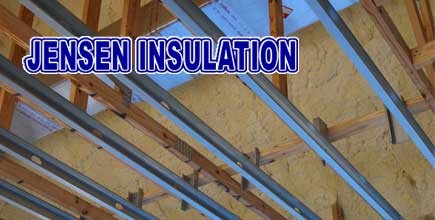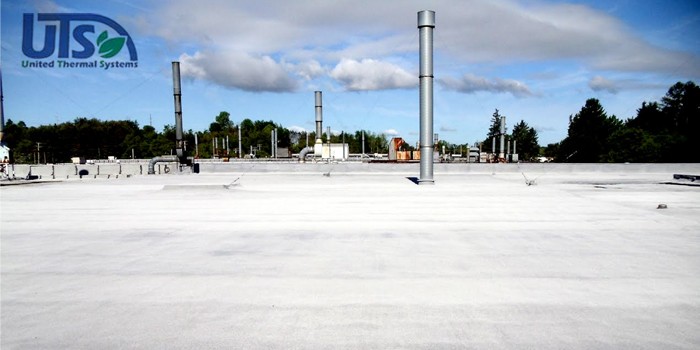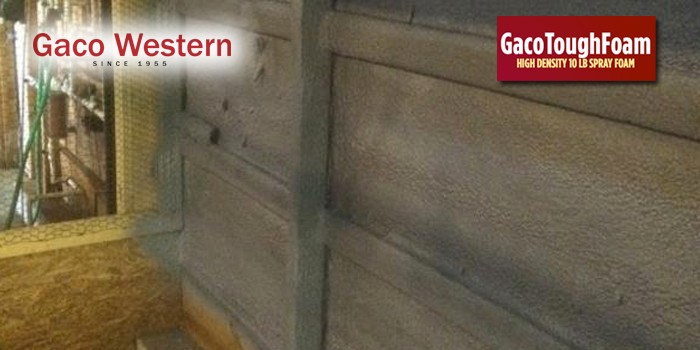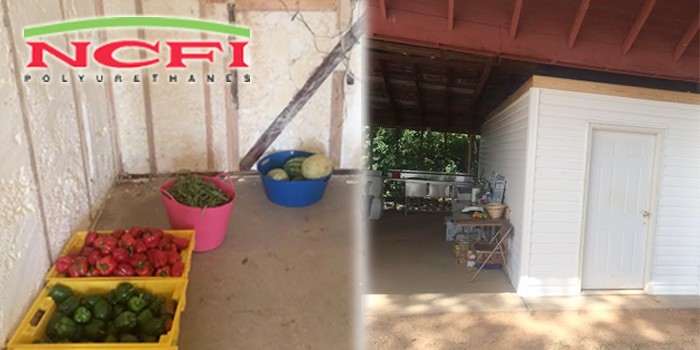New Florida Waterfront Home Insulated with Open and Closed-Cell Spray Polyurethane Foam

PALM BEACH, FL - June 17, 2013 - In warm and humid environments, good insulation is practically a necessity, particularly when owning a waterfront home. Case in point: a Florida resident whose new house is being constructed on an island along the Intracoastal Waterway decided it was best to have his home well insulated by the time his family is set to move in. SprayFoam.com was on site as the insulation project made headway.
The homeowner brought in Jensen Insulation for the job, which consisted of applying spray polyurethane foam to the underside of the roof, under the floor between the first and second stories, and the exterior walls. The cabana hut, which was separated from the main house, was also included in the SPF project.
Robert Giddings, general manager of Jensen Insulation, explained that the future residents of the home will greatly benefit from the spray foam insulation because it will act as a sealant that prevents moisture from getting into the home.
"A house on the water can definitely have issues due to moisture getting into the attic and the rest of the house," said Giddings. "Spray foam insulation seals the home from hot air and sea spray humidity."
The Jensen crew started with the roofline and is currently finishing up the application of SPF on the underside of the second floor. They've applied six inches of foam to both the underside of the roof and the underside of the second floor, which resulted in an R-value of 20. Three sets of GacoFireStop 5500, a 0.5 lb. open-cell spray foam insulation made by Gaco Western, were used on both substrates. According to Giddings, once the cabana and the garage are finished the total spray area will be 7,000 square feet.

The benefit of using GacoFireStop open-cell is that it has fire retardant built into the product, which vastly reduces material handling costs by not having to add an ignition barrier after the drywall is hung. Giddings explained the foam satisfied the building code Florida requires for SPF insulation without an ignition barrier.
For the project, the two-man Jensen crew had one rig on site equipped with a Graco Reactor E-30 proportioner and a Graco Probler P2 gun. The crew used three-layer Baker scaffolding to get up the roofline from the main floor, which had tall ceilings and a cathedral roof area with arches. They wore fresh air respirators and jumpsuits as the application progressed.
After they finish with the open-cell SPF installation, the Jensen crew will switch to closed-cell SPF insulation for the exterior wall application. They will, however, have to play the waiting game as other crews on site complete other tasks like the framework of the exterior walls, the electricity that needs to be put in place and the copper pipes that need to be installed. The windows have not arrived yet, which makes the home temporarily open and ventilated.
The Jensen crew is currently in the company of an A/C crew, a framework crew, a crew doing the dock waterfront side of the house, and a crew doing all the detail work for the home. Giddings mentioned that, even though he understands that it is a collaborative construction effort, it is tough to work around the other crews.
"The hardest part is working around everybody and working together without making anybody angry by getting in the way," said Giddings. "You have to be respectful of the other trades."
Once the windows arrive and they are installed, the crew will tape them down and mask them off prior to the spraying of closed-cell SPF, which will involve the application of two and a half inches of 1.5 lb. Gaco WallFoam. At this point, the crew will use air vacuums for ventilation.

The roofline application is now finished and the house is set to have ductwork installed in the next few days. Giddings said that SPF application will seal the roofline, which will keep all the ductwork cool and more efficient. He explained that if the home had batt insulation a dehumidifier would have to be installed because, since it's so close to the water, the climate in the attic would be exponentially humid, not to mention hot.
Giddings also added that the SPF insulation will regulate the temperature to the point that the environment from the main floor and the attic won't be that much different.
"There should be only about a 4 or 5 degree difference from the living area," said Giddings. "With no heat and no moisture, you could practically live up there… or at least store your tax documents."
Speaking of taxes, because of the SPF application the homeowner will receive a tax deduction incentive from Florida Power & Light of approximately $1,500 for keeping his home energy efficient by applying SPF, Giddings noted. He also mentioned that SPF provides insurance benefits for the homeowner should this house ever be afflicted by natural disaster.
"In the event of hurricane damage to the roof, an inspector would come to look at the roof to make sure it is foamed," said Giddings. "Depending on the homeowner's policy, up to 30% of the damage could be deducted."
On the other hand, Giddings felt compelled to note that SPF gives the roof structural rigidity, which bolsters the roofline and keeps air from coming underneath the house and popping off the roof. In a hurricane-prone area, SPF will provide more resistance and safety than any other kind of insulation.

In addition to cutting costs by way of tax incentives or insurance deductions, Giddings affirmed that the homeowner will be saving a hefty amount on energy bills.
"Spray foam is going to reduce the overall cost of energy bills by a large margin since it will be insulating such a large house," said Giddings. "By taking steps to be more energy efficient, the homeowner will find his bills not to be humongous, like the house."
Giddings claims that after the drywall is applied and the house is completely finished, the closed-attic system that keeps humidity out combined with energy efficient windows and doors will basically create a "Green"-er house.
About Jensen Insulation: Jensen Insulation was established in September 1987 as a small insulation company with one truck and a commitment to our customers. Since then, we have grown to become a family owned and managed company, providing excellent service and products, to the greater South Florida area. We serve all major counties including Broward, Palm Beach, Port St. Lucie and Indian County.
Throughout the years we have offered a wide range of great quality products. Insulation that stays in your home should perform well in your home. Our products and specialized installs range from spray foam, blown fiberglass and masonry wall cavity foam to fiber glass batts, roll insulation and rigid foam boards.
As a FPL Participating Independent Contractor, Jensen Insulation can insulate your home.
Disqus website name not provided.









































